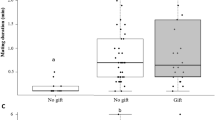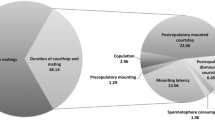Abstract
Male delivering of a prey packed in silk as a nuptial gift is rare in spiders and restricted until now to Pisauridae. Here, we describe this behavioral pattern found in two Trechaleidae species, Paratrechalea azul Carico 2005, and Paratrechalea ornata (Mello-Leitão 1943), mainly based on field observations. We observed the following steps of sexual behavior: sperm induction, nuptial gift construction, mate searching, pre-copulatory courtship, copulation, and copulatory ending. In this group, a nuptial gift consists of a prey wrapped in silk, which appears as a white rounded shape. The male carries his nuptial gift in his chelicerae while searching for a female. When he finds a female, he shows a stereotyped courting behavior consisting of a hyperflexed posture that is also assumed by the receptive female while they face each other. The copulatory position and pattern is similar to that found in other Lycosoidea: the male mounts the female and makes a total of four palpal insertions while alternating sides. However, after each palpal insertion the male dismounts and returns to a frontal position while biting the gift. Copulatory courtship is evidenced by palpal and leg movements. The copulation ends by female initiative and she almost always retains the nuptial gift. No case of pre-copulatory or post-copulatory cannibalism has been recorded. Descriptions of nuptial gift construction by males and copulation in these species, as well as hypotheses about the origin of nuptial gift construction among spiders, are presented. These descriptions are the first records of such nuptial gift offering for Neotropical spiders and for non-Pisauridae species as well.





Similar content being viewed by others
References
Austad SN, Thornhill R (1986) Female reproductive variation in a nuptial-feeding spider, Pisaura mirabilis. Bull Br Arachnol Soc 7:48–52
Bilde T, Tuni C, Elsayed R, Pekár S, Toft S (2006) Death feigning in the face of sexual cannibalism. Biol Lett 2:23–35
Bilde T, Tuni C, Elsayed R, Pekár S, Toft S (2007) Nuptial gifts of male spiders: sensory exploitation of the female’s maternal care instinct or foraging motivation? Anim Behav 73:267–273
Bösenberg W, Strand E (1906) Japanische Spinnen. Abh Senck naturf Ges 30:93–422
Bristowe WS, Locket GH (1926) The courtship of British lycosid spiders, and its probable significance. Proc Zool Soc 22:317–347
Carico JE (2005) Descriptions of two new spider genera of Trechaleidae (Araneae, Lycosoidea) from South America. J Arachnol 33:797–812
Clerck C (1757) Svenska spindlar, uti sina hufvud-slågter indelte samt under några och sextio sårskildte arter beskrefne och med illuminerade figurer uplyste. Stockholmiae, 154 pp
Coddington JA (2005) Phylogeny and classification. In: Ubick D, Paquin P, Cushing PE, Roth V. (eds) Spiders of North America: an identification manual. American Arachnological Society, pp 18–24
Costa FG, Capocasale RM (1984) Lycosa carbonelli sp. nov.: uma etoespecie simpátrida, sibilina de Lycosa thorelli (Keyserling) (Araneae, Lycosidae). J Arachnol 11:423–431
Costa FG, Viera C, Francescoli G (1997) Male sexual behaviour elicited by a hybrid pheromone: a comparative study on Lycosa thorelli, Lycosa carbonelli, and their hybrid progeny (Araneae, Lycosidae). Can J Zool 75:1845–1856
Eberhard WG (1985) Sexual selection and animal genitalia. Harvard University Press, Cambridge, Massachusetts
Eberhard WG (1996) Female control: sexual selection by cryptic female choice. Princeton University Press, Princeton, New Jersey
Fernandez-Montraveta C, Bellido JR, García JG (2001) La existencia de diferencias en el cortejo no garantiza su intervención en el aislamiento reproductor en dos arañas lobo (Lycosa, Araneae, Lycosidae). Etología 9:1–8
Fernandez-Montraveta C, Schmitt A (1994) Substrate-borne vibrations produced by male Lycosa tarantula fasciiventris (Araneae, Lycosidae) during courtship and agonistic interactions. Ethology 97:81–93
Foelix RF (1996) Biology of spiders—2nd edition. Oxford University Press, New York
Griswold CE (1993) Investigations into the phylogeny of the lycosoid spiders and their kin (Arachnida, Araneae, Lycosoidea). Smithsonian Contrib Zool 539:1–39
Huber BA (2005) Sexual selection research on spiders: progress and biases. Biol Rev 80:363–385
Itakura Y (1993) The life history and nuptial feeding of a nursery web spider, Pisaura lama. Insectarium 30:88–93
Itakura Y (1998) Discovery of nuptial feeding in the spider, Perenethis fascigera (Araneae, Pisauridae). Acta Arachnol 47:173–175
Jackson RR, Pollard SD (1997) Jumping spider mating strategies: sex among cannibals in and out of webs. In: Choe JC, Crespi, BJ (eds) The evolution of mating systems in insects and arachnids. Cambridge Univ. Press, Cambridge, UK, pp 340–351
Krafft B (1982) The significance and complexity of communication in spiders. In: Witt PN, Rovner JS (eds) Spider communication: mechanisms and ecological significance. Princeton University Press, Princeton, New Jersey, pp 15–66
Miller GL, Stratton GE, Miller PR, Hebets E (1998) Geographical variation in male courtship behaviour and sexual isolation in wolf spiders of the genus Schizocosa. Anim Behav 56:937–951
Peretti A, Eberhard WG, Briceño RD (2006) Copulatory dialogue: female spiders sing during copulation to influence male genitalic movements. Anim Behav 72(2):413–421 DOI 10.1016/j.anibehav.2006.01.014
Roberts JA, Uetz GW (2004) Chemical signaling in a wolf spider: a test of ethospecies discrimination. J Chem Ecol 30:1271–1284
Robinson MH (1982) Courtship and mating behavior in spiders. Annu Rev Entomol 27:1–20
Roland C, Rovner JS (1983) Chemical and vibratory communication in the aquatic pisaurid spider Dolomedes triton. J Arachnol 11:77–85
Sakaluk SK (2000) Sensory exploitation as an evolutionary origin to nuptial food gifts in insects. Proc R Soc Lond B 267:339–343
Schneider JM, Lubin Y (1998) Intersexual conflict in spiders. Oikos 83:469–506
Silva D (2003) Higher-level relationships of the spider family Ctenidae (Araneae: Ctenoidea). Bull Amer Mus Nat Hist 274:1–86
Silva ELC, Lise AA, Buckup EH, Brescovit AD (2006) Taxonomy and new records in the Neotropical spider genus Paratrechalea (Araneae, Lycosoidea, Trechaleidae). Biociências 14:71–82
Simó M, Seguí R, Pérez-Miles F (2002) The copulatory organs of the cryptic species Lycosa thorelli and Lycosa carbonelli and their hybrid progeny, with notes on their taxonomy (Araneae, Lycosidae). J Arachnol 30:140–145
Simon E (1898) Descriptions d’arachnides nouveaux des familles des Agelenidae, Pisauridae, Lycosidae et Oxyopidae. Ann Soc ent Belg 42:1–34
Stålhandske P (2001) Nuptial gift in the spider Pisaura mirabilis maintained by sexual selection. Behav Ecol 12:691–697
Stålhandske P (2002) Nuptial gifts of male spiders function as sensory traps. Proc R Soc Lond B 269:905–908
Stratton GE, Hebets EA, Miller PR, Miller GL (1996) Pattern and duration of copulation in wolf spiders (Araneae, Lycosidae). J Arachnol 24:186–200
Thorell T (1869) On European spiders. Part I. Review of the European genera of spiders, preceded by some observations on zoological nomenclature. Nova Acta reg Soc sci Upsaliae 7:1–108
Vahed K (1998) The function of nuptial feeding in insects: a review of empirical studies. Biol Rev 73:43–78
Vahed K (2007) All that glisters is not gold: sensory bias, sexual conflict and nuptial feeding in insects and spiders. Ethology 113:105–127
Acknowledgments
We thank Fernando G. Costa, Lucas C. T. Silveira, Kari Benson, Nelle A. Carico and Anita Aisenberg for manuscript reading and suggesting important improvements in previous versions, Adriano Andrejew, Cristiano A. Iserhard, Patrick Colombo, Lucas C. T. Silveira and Clarisse Palma for field support, Alvaro Laborda, Miguel Simó, Paulo Motta, William Eberhard and João Vasconcellos-Neto for personal communications. We also thank Mark Elgar, Karim Vahed and an anonymous referee for constructive comments on earlier versions of the manuscript. The present study was supported by a grant from the National Council for Scientific and Technological Development (CNPq—Brazil), awarded to LECS. All animal collections comply with the current laws of the Brazil government, represented by IBAMA, which issued all the collections permits.
Author information
Authors and Affiliations
Corresponding author
Appendix
Appendix
Rights and permissions
About this article
Cite this article
Costa-Schmidt, L.E., Carico, J.E. & de Araújo, A.M. Nuptial gifts and sexual behavior in two species of spider (Araneae, Trechaleidae, Paratrechalea). Naturwissenschaften 95, 731–739 (2008). https://doi.org/10.1007/s00114-008-0379-7
Received:
Revised:
Accepted:
Published:
Issue Date:
DOI: https://doi.org/10.1007/s00114-008-0379-7




